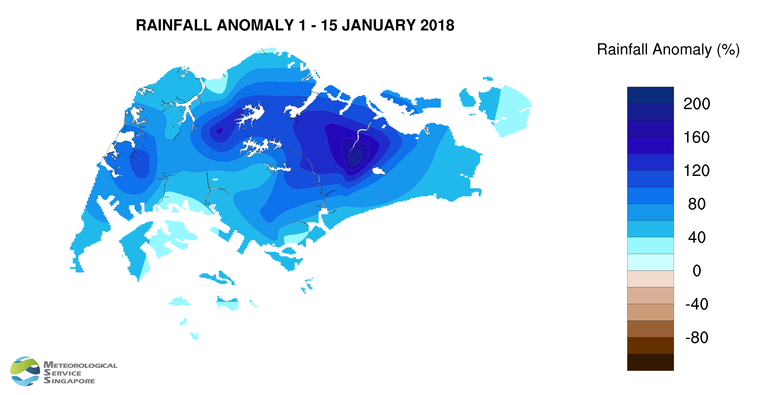Short-duration thundery showers expected between the afternoon and evening on most days in the next fortnight. Rainfall expected to be well-above normal in January 2018.
Singapore, 16 January 2018 – The prevailing Northeast Monsoon season is forecast to continue into the second fortnight of 2018. For the next two weeks, the low level winds over Singapore and the surrounding region are forecast to blow mostly from the northeast or northwest.
2 The second fortnight of January 2018 is not expected to be as wet as the first fortnight of the month. In the second half of the month, five to seven days of short-duration thundery showers are expected in the afternoon, and could extend into the evening on a few days. The passage of Sumatra squalls is expected to bring widespread thundery showers coupled with occasional gusty winds over Singapore between the predawn and early morning on one or two days. Overall, the rainfall for January 2018 is expected to be well above normal.
3 During the second fortnight of January 2018, the daily temperatures are forecast to range between 24°C and 32°C. On some rainy days, cooler temperatures can be expected with the daily maximum temperature ranging between 27°C and 29°C, and the daily minimum temperature ranging between 23°C and 24°C.
4 For updates of the daily weather forecast, please visit the MSS website (https://www.weather.gov.sg), NEA website (www.nea.gov.sg), or download the myENV app, MSS’ Weather@SG app.
REVIEW (1 – 16 January 2018)
5 Northeast Monsoon conditions prevailed over Singapore and the surrounding region in the first two weeks of 2018. The low level winds during this first fortnight were predominantly from the northeast or northwest, and rain fell over the island almost every day.
6 A monsoon surge affected the South China Sea and the surrounding region over three days from 30 December 2017 to 1 January 2018. On 1 January 2018, as the surge weakened, the day was cloudy and occasionally windy, accompanied by periods of light to moderate rain. It was also cool with daily temperatures ranging from 22.7°C to 27.3°C. On several days in the first week of the year, moderate to heavy thundery showers fell in the afternoon and evening due to strong solar heating of land areas coupled with convergence of winds. On 8 January, a temporary change in the winds to blow from the southwest led to the passage of a Sumatra squall in the predawn hours and morning. The squall brought widespread thundery showers over the island, with the rainfall station at Paya Lebar recording 131.8mm of rain in a day. This was the highest total daily rainfall recorded in the first fortnight of January 2018.
7 In the second week of January 2018, another monsoon surge affected the South China Sea and the region between 10 and 14 January. The surge brought overcast skies, windy conditions and widespread rain to Singapore for five consecutive days. Over this period, the daily maximum temperature was between 24.3°C and 28.5°C while the daily minimum temperature dipped to a low of between 21.2°C and 22.4°C.
8 In the first fortnight of 2018, the daily maximum temperature ranged between 24.3°C and 33.2°C, and the daily minimum temperatures ranged between 21.2°C and 23.7°C. The lowest temperature of 21.2°C was recorded on 14 January 2018 at Admiralty and Jurong West.
9 Singapore received significantly above normal rainfall in the first fortnight of January 2018. The highest rainfall of 339.4mm (206% above average) was recorded at Paya Lebar. Rainfall was lowest around the Bukit Panjang area where 162.5mm (44% above average) was recorded.

CLIMATE STATION STATISTICS FOR JANUARY (Climatological reference period: 1981 – 2010)
| Mean daily maximum temperature |
30.4 °C |
| Mean daily minimum temperature |
23.9 °C |
| Mean monthly temperature |
26.5 °C |
| Mean rainfall for the month |
234.6 mm |
| Mean number of rain days |
13 |
| Highest monthly mean daily maximum temperature |
31.8 °C (1998) |
| Lowest monthly mean daily minimum temperature |
22.6 °C (1981, 1982) |
| Highest monthly rainfall |
600.9 mm (2004) |
| Lowest monthly rainfall |
15.4 mm (1997) |